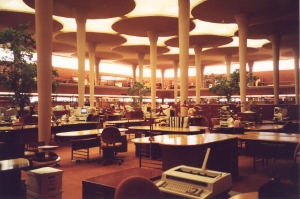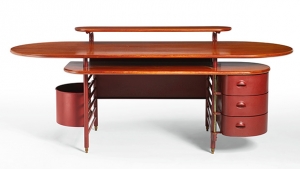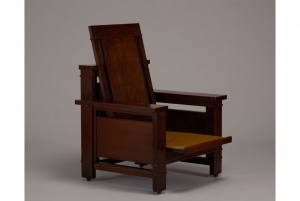|
Displaying items by tag: frank lloyd wright

On May 2, Frank Lloyd Wright’s S.C. Johnson Research Tower in Racine, Wisconsin, will open to the public for the first time since it was completed in 1950. Visually striking but functionally flawed, the fifteen-story industrial tower was shuttered in 1982, but not before gaining National Register of Historic Places status in 1976.
Noted for its tree-like structure, the S.C. Johnson Research Tower is regarded as one of the country’s most important examples of cantilevered architecture. The Tower’s floors are supported by a central core, which houses a narrow stairway, small elevator, and utility lines. Glass tubes surround the tower, providing natural light, which proved overly efficient on hot days. Despite its imperfections, Johnson employees created some of the brands most ubiquitous products (Glade air freshener, Pledge furniture polish, and insecticides Off! and Raid) within the Tower's walls.
After researchers moved out of the Tower over thirty years ago, the building sat mostly empty until this year, when S.C. Johnson finished a five-year, $30 million renovation of the Research Tower and neighboring Administration Center, which was also designed by Wright and opened in 1939. The Administration Center relies on pillars for structural support, which allowed Wright to use glass tubing for exterior walls, much like he did for the Research Tower. Wright also designed the furnishings for the S.C. Johnson Research Tower and Administration Center.
Visitors to the S.C. Johnson complex can explore a new exhibit focused on Wright’s homes in Spring Green, Wisconsin, and Scottsdale, Arizona. The show was organized in partnership with the Milwaukee Art Museum and the Frank Lloyd Wright Foundation and includes some of the architect’s own home movies. A second exhibition presents a mock research lab from the 1950s, complete with beakers, flasks, centrifuges, balances, test tubes, and graduated cylinders found in company storage rooms.
Wright, a Wisconsin native, designed commercial buildings, apartment towers, recreational complexes, museums, religious houses, residences, furniture, lighting features, textiles, and art glass. According to the Frank Lloyd Wright Foundation, “he redefined our concept of space, offering everyone the opportunity to live and grow in nourishing environments, connected physically and spiritually to the natural world.”
Free, two-hour tours of the Research Tower and Administration Center will be offered from 9AM to 2:30PM Fridays, Saturdays, and Sundays through September 27.

The Los Angeles County Museum of Art, the Art Institute of Chicago, the Dallas Museum of Art, the National Gallery of Art in Washington, D.C., and the Whitney Museum of American Art in New York are joining forces with the Outdoor Advertising Association to execute the “outdoor art show,” Art Everywhere. The interactive art campaign will display images of the greatest American artworks on billboards and signs in select cities across the United States.
The participating museums have created a master list of 100 American artworks from their combined holdings and are asking the public to visit www.ArtEverywhereUS.org and vote for their favorite pieces. The 50 most popular works will be featured throughout August on approximately 50,000 billboards and signs across the country. Art Everywhere’s master list includes paintings, drawings, decorative objects, photographs, and multimedia works from the 18th century to 2008. Artists represented on the ballot include Edward Hopper, Mark Rothko, John Singer Sargent, Mary Cassatt, Ed Ruscha, Andy Warhol, Cindy Sherman, Frank Lloyd Wright, Georgia O’Keeffe, and Jackson Pollock.
Voting will remain open until June 20 and the chosen works will be unveiled on August 4.

S.C. Johnson & Son, a global manufacturer of household cleaning supplies and other consumer chemicals, has filed a lawsuit against Sotheby’s. The lawsuit concerns a rare desk and chair from the Frank Lloyd Wright-designed S.C. Johnson & Son Administration Building in Racine, Wisconsin. The furniture, which was slated to be the highlight of the auction house’s upcoming 20th century design sale on December 18, exemplifies American Modernism.
According to a complaint filed in a New York federal court, S.C. Johnson claims that that the desk and chair are stolen goods. While the company does loan furniture and objects designed by Wright to museums, selling works is against their policy. The company’s statement went on to say that the removal of the desk and chair from the Administration Building was not authorized.
The sale’s catalogue lists the provenance of the desk as having been acquired by the chemist Elerslie E. Luther from S.C. Johnson during the early 1950s. The desk was alleged passed on by descent until it reached the current owner who acquired it from Jeffrey V. Luther. However, there is no evidence of a connection between Luther and S.C. Johnson in the company’s records. Similarly, the catalogue lists the chair as having been gifted by Samuel C. Johnson to a private collector in 1972. However, the bequest in inconsistent with S.C. Johnson’s records.
The desk is estimated to sell for $400,000 to $600,000 while the chair is expected to net $80,000 to $120,000.
This August and September, the Solomon R. Guggenheim Museum in New York will offer members an exclusive look at James Turrell’s major site-specific work Aten Reign. The popular installation will be showcased in Quiet Views, allowing visitors the chance to experience the luminous and immersive work in an intimate and meditative environment.
James Turrell, an American artist who is best known for his works that explore light and space, spent nearly six years planning the massive installation that has transformed the Guggenheim’s iconic Frank Lloyd Wright-designed rotunda. Quiet Views consists of four events taking place on the evenings of August 12, August 19, September 9, and September 23 and will include two sittings on each day. Only sixty people will be present at each hour-long sitting.
James Turrell was organized by the Guggenheim in collaboration with the Los Angeles County Museum of Art and the Museum of Fine Arts, Houston.
In an attempt to attract visitors from outside the region, a number of Pittsburgh institutions have embarked on a joint endeavor called the Pittsburgh Art and Architecture Tour. The Andy Warhol Museum, the Mattress Factory Art Museum and two seminal residences designed by Frank Lloyd Wright, Fallingwater and Kentucky Knob, make up the tour.
The arrangement was made possible by a planning grant from the Pittsburgh-based Benter Foundation, an organization aimed at making the city more culturally and socially vibrant. The Warhol Museum’s Director, Eric Shiner, said, “We are very excited about this collaborative effort to increase cultural tourism to the Pittsburgh region.”
The Pittsburgh Art and Architecture Tour’s website, www.pghtrip.org, offers sample itineraries by car, air and public transportation that include the best places to stay, eat and visit while in the area.

A rare and early reclining armchair designed by American architect Frank Lloyd Wright (1867-1959) is currently on view at the Currier Museum in Manchester, NH. A pioneer of modern architecture, Wright designed the chair between 1902 and 1903 and it features the minimal aesthetic and linear design that he is best known for. The chair was originally designed for his prairie style Francis W. Little House in Peoria, IL but he used different variations of the chair over the course of the next decade, including in his own studio in Chicago’s Oak Park.
The presentation of the chair coincides with the reopening of the Currier’s Isadore J. and Lucille Zimmerman House (1950), which Wright designed. Along with the exterior, Wright devised the House’s interiors, furniture, gardens, and even its mailbox. The Zimmermans left the house to the Currier in 1988 and it opened for public tours in 1990. Besides being able to view a Wright masterpiece, visitors are offered a glimpse of the Zimmermans’ personal collection of modern art, pottery, and sculpture. The Zimmerman House is the only Wright home open to the public in New England. It was listed in the National Register of Historic Places in 1979.
Tours of the Zimmerman House are offered ten times a week and require a reservation.

For the first time in its 187-year history, the New York-based National Academy will welcome photographers, video artists, and performance artists to its organization. A community of artists, students, museum-goers, and supporters of the arts, the National Academy had previously only allowed painters, sculptors, printmakers, and architects to be voted into membership. Known as National Academicians, each year since 1825 a select group of the country’s most celebrated artists are elected to become members of the Academy.
This year’s inductees include the video and performance artist Joan Jonas (b. 1936), photographer Cindy Sherman (b. 1954), and video artist Bill Viola (b. 1951). Twenty other newly elected visual artists and architects will join the Academy’s 300+ active members this year. After being inducted, each Academician presents the Academy Museum with a selection from their oeuvre. The National Academy Museum’s permanent collection currently includes over 7,000 works. Past and present National Academicians include Andrew Wyeth (1917-2009), Frank Lloyd Wright (1867-1959), and Frank Gehry (b. 1929).
The National Academy also includes the Academy School, which offers studio-based classes. Over 30 faculty members lead courses and workshops in painting, drawing, sculpture, new media, video and photography, printmaking, mixed media, and art theory.

New York’s Metropolitan Museum of Art, the largest art museum in the United States, can be difficult to navigate in a short period time. With over two million works in its collection, visitors to the Met usually spend a few minutes with an object before moving on to one of the many masterpieces that awaits them. In an effort to highlight some of the museum’s not-to-be-missed objects, Met officials have launched the web series, 82nd & Fifth, aptly named after the museum’s Manhattan location.
The series presents 100 pieces from the Met’s vast collection in separate episodes. During each episode, a museum curator explains the work’s significance, not just to the art world and the museum, but also to them on a personal level.
The Met has already posted six 2-½ to 3-minute videos, which include interactive features, on the 82nd & Fifth web page. Highlighted works include a room with furnishings designed by Frank Lloyd Wright (1867-1959) between 1912 and 1915, a Renaissance relief sculpture by Antonio Rossellino (1427-circa 1478/1481), Giovanni Battista Tiepolo’s (1696-1770) massive painting The Triumph of Marius (1729), and an etching by Rembrandt (1606-1669) titled Christ Crucified Between Two Thieves: The Three Crosses (1653).
The Met will post two new videos on Wednesday morning of each week through December 25, 2013.

A house built in 1952 by Frank Lloyd Wright for his son, David, has spent months on the brink of demolition. Fortunately, an anonymous buyer has purchased the Phoenix, Arizona home, ensuring its preservation.
The buyer paid $2.387 million for the house, which overlooks the picturesque Camelback Mountains. The former owners, Steve Sells and John Hoffman of the Arizona-based development company, 8081 Meridian, continued to raise the price of the house after purchasing the property for $1.8 million this past June.
The Frank Lloyd Wright Building Conservancy, an organization devoted to preserving the seminal architect’s legacy, facilitated the recent sale. After hearing that the former owners planned to level the house and split the lot to build new homes, the conservancy petitioned the city with the help of other organizations, asking that the house be granted landmark status. While three local government bodies approved the proposal, the City Council, which would be the deciding vote, repeatedly postponed their decision.
One of Wright’s most significant later works, the house in Phoenix features a coiled design similar to the one Wright employed for the Guggenheim Museum in New York. For years ago, Wright’s granddaughters decided to sell the house to a buyer they thought would preserve it. However, the house was sold again in June to 8081 Meridian putting it in danger of demolition.
While the house is in need of approximately $300,000 worth of restoration, the conservancy is helping to establish a nonprofit organization that will maintain and operate the house as well as oversee the renovation. The new owner plans to acquire landmark status for the house so that it can be made available for educational purposes on a limited basis.

The Huntington Library, Art Collections, and Botanical Gardens acquired thirteen pieces of furniture by the American architect, Frank Lloyd Wright. The selection of furniture had previously been on display at the Library since 2009 as part of a long-term loan from the prominent New York collectors, Joyce and Erving Wolf. The purchase was made directly from the Wolfs for an undisclosed amount.
The highlight of the group is a nine-piece dining room suite designed in 1899 for the now-demolished Husser House in Chicago. The commission marked a turning point in Wright’s career as he moved away from his more architecturally rigid views on interiors towards the notion that interior space can be open and flowing. The other four pieces in the acquisition were from signature Wright houses in Illinois including the Avery Coonley House, the Arthur Heurtley House, the Little House (which has been demolished), and the Ward W. Willits House.
One of the greatest architects of the 20th century, Wright played a pivotal part in changing design sensibilities from the highly ornate styles of the late-19th century to more streamlined designs for modern times. In addition to developing plans for upward of a thousand buildings, Wright designed furniture, leaded-glass windows, light fixtures, metal ware, and textiles – all made to harmonize with the buildings for which they were intended.
|
|
|
|
|